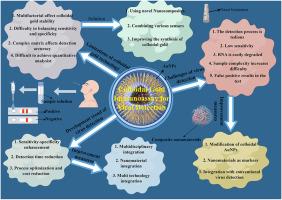胶体金技术在病毒诊断:最近的创新,临床应用,和未来的前景
IF 2.4
3区 医学
Q3 VIROLOGY
引用次数: 0
摘要
胶体金技术通过其快速、经济、用户友好的应用,特别是在护理点检测(POCT)中,彻底改变了病毒诊断。本文综述了近年来的研究进展,重点介绍了其在检测呼吸道病毒、肝炎病毒和新发病原体方面的作用。该技术利用了金纳米颗粒(AuNPs)独特的光学和物理化学性质,包括局部表面等离子体共振(LSPR)和高表面体积比,在15分钟内实现抗原抗体的快速识别。crispr - cas集成侧流免疫测定(LFIAs)、双模等离子体生物传感器和纳米材料(如ceo2 -胶体金复合材料)等创新技术提高了灵敏度和多重功能,能够同时识别共循环病原体。病例研究强调了其在登革热血清分型、SARS-CoV-2中和抗体定量和HBV/HCV共检测方面的有效性,显示出较高的临床特异性。然而,挑战依然存在,包括需要提高敏感性;具有抗扰性的样品基质干扰;交叉反应引起的假阳性;半定量分析的局限性。最近在混合纳米材料合成、表面功能化和设备级多路复用(加上人工智能驱动的数据解释)方面的进展有望解决这些空白。未来的趋势强调与表面增强拉曼散射(SERS)、微流体和便携式传感器的集成,以实现低于10摩尔的灵敏度和可扩展的部署。通过将纳米技术与精确诊断相结合,胶体金平台有望重新定义全球病毒监测,特别是在资源有限的情况下,强调它们在大流行防范中不可或缺的作用。本文章由计算机程序翻译,如有差异,请以英文原文为准。

Colloidal gold technology in viral diagnostics: Recent innovations, clinical applications, and future perspectives
Colloidal gold technology has revolutionized viral diagnostics through its rapid, cost-effective, and user-friendly applications, particularly in point-of-care testing (POCT). This review synthesizes recent advancements, focusing on its role in detecting respiratory viruses, hepatitis viruses, and emerging pathogens. The technology leverages the unique optical and physicochemical properties of gold nanoparticles (AuNPs), including localized surface plasmon resonance (LSPR) and high surface-to-volume ratios, to achieve rapid antigen-antibody recognition with visual readouts within 15 min. Innovations such as CRISPR-Cas-integrated lateral flow immunoassays (LFIAs), dual-mode plasmonic biosensors, and nanomaterials like CeO2-colloidal gold composites have enhanced sensitivity and multiplex capability, enabling simultaneous identification of co-circulating pathogens. Case studies highlight its efficacy in dengue serotyping, SARS-CoV-2 neutralizing antibody quantification, and HBV/HCV co-detection, demonstrating high clinical specificity. However, challenges persist, including the need for improved sensitivity; interference of sample matrix with immunity; false positives caused by cross-reactions; and limitations of semi-quantitative analysis. Recent progress in hybrid nanomaterial synthesis, surface functionalization, and device-level multiplexing—coupled with AI-driven data interpretation— promises to address these gaps. Future trends emphasize integration with surface-enhanced Raman scattering (SERS), microfluidics, and portable sensors to achieve sub-zeptomolar sensitivity and scalable deployment. By bridging nanotechnology with precision diagnostics, colloidal gold platforms are poised to redefine global viral surveillance, particularly in resource-limited settings, underscoring their indispensable role in pandemic preparedness.
求助全文
通过发布文献求助,成功后即可免费获取论文全文。
去求助
来源期刊

Virology
医学-病毒学
CiteScore
6.00
自引率
0.00%
发文量
157
审稿时长
50 days
期刊介绍:
Launched in 1955, Virology is a broad and inclusive journal that welcomes submissions on all aspects of virology including plant, animal, microbial and human viruses. The journal publishes basic research as well as pre-clinical and clinical studies of vaccines, anti-viral drugs and their development, anti-viral therapies, and computational studies of virus infections. Any submission that is of broad interest to the community of virologists/vaccinologists and reporting scientifically accurate and valuable research will be considered for publication, including negative findings and multidisciplinary work.Virology is open to reviews, research manuscripts, short communication, registered reports as well as follow-up manuscripts.
 求助内容:
求助内容: 应助结果提醒方式:
应助结果提醒方式:


